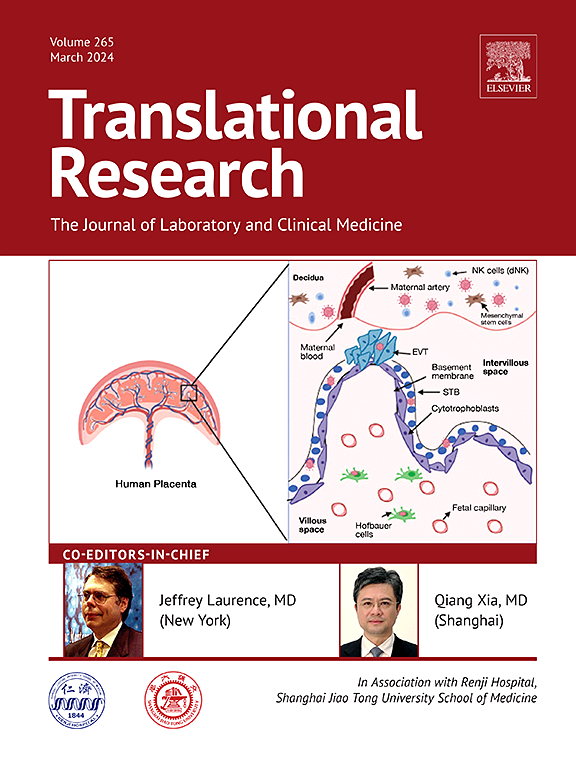Multiplexed imaging-driven single-cell analysis of abdominal aortic aneurysm according to C-reactive protein deposition
IF 5.9
2区 医学
Q1 MEDICAL LABORATORY TECHNOLOGY
引用次数: 0
Abstract
Abdominal aortic aneurysm (AAA) is an age-related, life-threatening condition characterized by the expansion of the abdominal aorta. Serum C-reactive protein (CRP) levels are a prognostic marker for AAA, and CRP accelerates tissue injury when deposited in damaged cell membranes in its monomeric form (mCRP). We previously showed that mCRP deposits in eroded atherosclerotic regions are associated with increases in inflammatory cell infiltration and aortic diameter. To investigate the changes in inflammatory-stromal cellular landscape associated with mCRP deposition, we used Co-Detection by Indexing (CODEX) tissue imaging with 31 nucleotide-barcoded antibodies and single-cell-based unsupervised clustering. AAA cases were categorized into High-CRP (n = 6) and Low-CRP (n = 3) groups based on serum levels and immunohistochemistry scores of mCRP. We identified 47 distinct immune and stromal cell types, revealing significant differences in protein expression between groups. In AAA, stromal cells decreased while immune cells increased. High-CRP cases showed increased M1-like and Ki67+ proliferating macrophages, and reduced αSMA+ cells, whereas Low-CRP cases exhibited intensified fibrosis with CD163+Ki67+ proliferating M2-like macrophages. Spatial neighborhood enrichment analysis highlighted the close proximity of CD4+FOXP3+PDL1+ Treg cells to specific clusters: (1) CD57+granzyme B+ cytotoxic NK cells, (2) CD31+HLA-A+ endothelial cells, (3) CD45+lymphocytes/CD31+ endothelial cells, and (4) CD45+CD20+ B cells in High-CRP cases. Our findings demonstrate the varying distribution of immune cells and vascular wall phenotypes in AAA according to mCRP deposition levels. Targeting inflammation, specifically the immune cells, macrophages, and fibrosis affected by mCRP, may represent a novel approach to halting the pathogenesis of AAA.
基于c反应蛋白沉积的多路成像驱动单细胞分析腹主动脉瘤。
腹主动脉瘤(AAA)是一种以腹主动脉扩张为特征的年龄相关性、危及生命的疾病。血清c反应蛋白(CRP)水平是AAA的预后指标,当CRP以单体形式(mCRP)沉积在受损细胞膜中时,会加速组织损伤。我们之前的研究表明,侵蚀动脉粥样硬化区域的mCRP沉积与炎症细胞浸润和主动脉直径的增加有关。为了研究与mCRP沉积相关的炎症基质细胞景观的变化,我们使用了索引(CODEX)组织成像与31个核苷酸条形码抗体和基于单细胞的无监督聚类的共同检测。根据血清mCRP水平及免疫组化评分将AAA患者分为高crp组(n=6)和低crp组(n=3)。我们鉴定了47种不同的免疫细胞和基质细胞类型,揭示了组间蛋白表达的显著差异。在AAA中,基质细胞减少,免疫细胞增加。高crp患者表现为m1样和Ki67+增殖性巨噬细胞增多,αSMA+细胞减少,而低crp患者表现为CD163+Ki67+增殖性m2样巨噬细胞纤维化加剧。空间邻域富集分析强调了CD4+FOXP3+PDL1+ Treg细胞与特定细胞簇的密切关系:(1)CD57+颗粒酶B+细胞毒性NK细胞,(2)CD31+HLA-A+内皮细胞,(3)CD45+淋巴细胞/CD31+内皮细胞,以及(4)高crp病例中的CD45+CD20+ B细胞。我们的研究结果表明,根据mCRP沉积水平,AAA中免疫细胞和血管壁表型的分布不同。靶向炎症,特别是受mCRP影响的免疫细胞、巨噬细胞和纤维化,可能是一种阻止AAA发病机制的新方法。
本文章由计算机程序翻译,如有差异,请以英文原文为准。
求助全文
约1分钟内获得全文
求助全文
来源期刊

Translational Research
医学-医学:内科
CiteScore
15.70
自引率
0.00%
发文量
195
审稿时长
14 days
期刊介绍:
Translational Research (formerly The Journal of Laboratory and Clinical Medicine) delivers original investigations in the broad fields of laboratory, clinical, and public health research. Published monthly since 1915, it keeps readers up-to-date on significant biomedical research from all subspecialties of medicine.
 求助内容:
求助内容: 应助结果提醒方式:
应助结果提醒方式:


